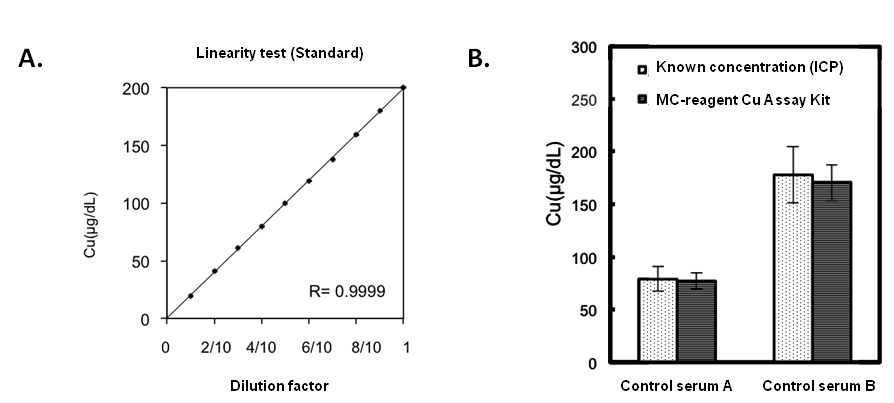
Copper Colorimetric Assay Kit (3,5-DiBr-PAESA Method)
JAI-CCU-400
Product group Chemicals
Product JAI-CCU-400 is not available
Product not available
There may be an alternative product available, please contact our technical support team.
Overview
- SupplierJaICA
- Product NameCopper Colorimetric Assay Kit (3,5-DiBr-PAESA Method)
- Delivery Days Customer10
- CertificationResearch Use Only
- Scientific DescriptionCopper (Cu+) is an essential trace element (i.e. micronutrient) and cofactor. 95% of copper in plasma is in complex with enzymes, mostly with ceruloplasmin, several oxidases and dismutases, which play important roles in iron and catecholamine metabolism, free radical scavenging, and in the synthesis of haemoglobin and elastin. The micronutrient is necessary for the proper growth, development, and maintenance of bone, connective tissue, brain, heart, and many other body organs. Copper is involved in the formation of red blood cells, the absorption and utilization of iron, the metabolism of cholesterol and glucose, and the synthesis and release of life-sustaining proteins and enzymes. These enzymes in turn produce cellular energy and regulate nerve transmission, blood clotting, and oxygen transport. Copper stimulates the immune system to fight infections, to repair injured tissues, and to promote healing. Copper also helps to neutralize free-radicals, which can cause severe damage to cells. Copper deficiency lowers the anti-oxidant function in vivo and has been associated with mental retardation, depigmentation, anemia, hypotonia and scorbutic changes in bone. Levels of copper are key diagnostic indicator of diseases such as cardiopathy, osteoporosis, osteoarthritis, Menkes syndrome and Wilsons disease. Acute copper toxicity can cause gastroenteritis and acute renal failure. - This MC-Reagent Copper Assay Kit is a direct colorimetric assay based on the 3,5-DiBr-PAESA method without deproteinization of the sample. A week acid buffer dissociates copper from the ceruloplasmin-copper complex and is reduced by ascorbic acid (Cu2+ >> Cu+). Cu+ ions form a blue colored complex with the chromogen 3,5-DiBr-PAESA. The color intensity is proportional to the copper concentration in the sample. Absorbance of the Cu+-complex is measured at 580nm. Wavelength range of sensitivity: 570 ~ 590nm. Features of this Assay: Quick & Easy to use Species independent Highly sensitive, stable and suitable for high-throughput testing No toxic substances For cell lysates, serum, plasma and wide variety of biological samples
- Storage Instruction2°C to 8°C
- UNSPSC12352200
